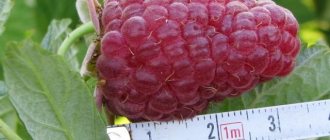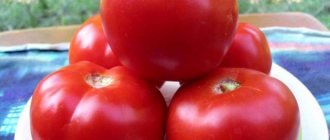Early remontant raspberries Red Guard are classified as elite varieties. The crop was so named for its uniform, large, beautiful, cone-shaped, dark red, shiny berries. This selection was developed in 2005 by V.I. Kazakov, a prominent scientist, leading breeder.
AGRO PREMIUM is an innovative, environmentally friendly plant activator, without chemicals, that protects berries, fruits and vegetables from pests and diseases, increases seed germination, stimulates root formation and plant growth, and significantly increases productivity.
Gardeners consider these raspberries to be the best. It has powerful bushes and erect shoots. A crop with an extended fruiting period from mid-late July to October.
Description of raspberry Red Guard
Ease of care is due to the young shoots planted close to each other. Plants with large berries elongated by 4-5 cm, weighing from 15 to 18 g. The crop bears fruit for a long time - from 1.5 to 2 months.
According to gardeners, this is an ideal raspberry with remontant qualities:
- The berries have an excellent marketable appearance.
- Fruits with high taste qualities.
- A crop with good yield.
- And with excellent self-fertility, which facilitates reproduction.
- With good branching of shoots, on the branches of which most of the fruits are located.
- With white flowers from the 15th to the last days of June.
- With high frost resistance, down to -30 degrees.
- The foliage is large, wrinkled, dark green.
Plant care
The Yellow Giant variety is easy to care for and is also resistant to common pests and diseases that affect raspberry bushes and fruits.
Trimming
For the winter, the shoots are tied up and not pruned. This leads to an earlier harvest, but the yield will be lower and the fruits will be smaller.
- When pruning in spring, all dried, damaged branches that did not survive the winter are removed at the root every year. The remaining branches are pruned to the first healthy bud.
- In the fall, 3 weeks before the onset of frost, all weak shoots are removed at the root.
Pruning is the most important step in caring for raspberries.
Pruning raspberries (video)
Watering
In the southern regions, raspberries are watered at least 5 times:
- during the growing season;
- in the phase of intensive growth;
- during the flowering period;
- during the formation of ovaries;
- after harvesting.
In the middle zone, 3-4 times are enough: during the growing season and shoot growth, after harvesting.
One bush requires about 3-5 buckets of water. Watering is carried out by sprinkling or in specially formed grooves.
Shelter for the winter
The Yellow Giant raspberry variety is frost-resistant, but at temperatures below 30 degrees it requires shelter for the winter. The bushes are removed from the trellis, tied and bent to the ground, strengthened with specially prepared metal hooks. The distance from the ground in a bent state should be no more than 40 cm. Then the bushes are covered with straw, and a little later with snow.
Be sure to bend the raspberries for the winter - this will protect the plant from frost.
Top dressing
If fertilizers were applied when planting raspberries, then the plant does not require additional feeding for the first 3 years. In subsequent years, during spring digging, nitrogen fertilizers are added, as well as 200 g of ash and 80–100 g of potassium sulfate per 1 sq. m. m during fruiting.
Raspberry feeding must be carried out in early spring, when the soil around the bush is first loosened
Planting remontant raspberries Red Guard
In order for Red Guard raspberry yields to be high, fertile soil is necessary. And such an aspect as the location of the raspberry tree is also important.
The Red Guard raspberry will show its responsiveness to a good, illuminated raspberry patch with deep underground waters. 1.5 or more m.
It is necessary to plant raspberries where strong winds do not reach the crop. So that there is a lot of snow in that place even in winter. Plantings are carried out in the spring season, before the buds open, or in the autumn.
The earth is prepared in advance. For spring - autumn. For autumn - a month, a month and a half. A distance of 1.5-2 m is made between rows, and 0.5 m between bushes.
Important! The most optimal method is the tape planting method. That is, plants are placed in a single-row manner. A linear meter should contain from 10 to 12 shoots. If you follow this scheme, you can get from 5 to 5.5 kg of berries from one bush.
Agricultural technology
If the listed advantages of the variety are more than enough for you, and the mentioned minor disadvantages of the plant do not repel you, then you should pay attention to the issue of proper cultivation of raspberries, taking into account the requirements for the planting site and further care of the planted seedlings.
Important! To maintain order, you have to regularly destroy root growth, thereby controlling the growth of bushes and preventing the development of possible diseases in their thickets.
Selecting a location
The yield of raspberries of the Red Guard variety directly depends on the composition of the soil in the place where it is grown, so make sure that the substrate on the site is loose, with a high content of humus and a rich mineral composition.
In addition, a sufficient amount of sunlight is important for any raspberry, which means choose only places that are well-warmed by the rays and at the same time protected from cold gusts of wind from the north side . Waterlogged areas with groundwater close to the surface are the least suitable option for the crop, but if there is no choice, then you will have to take care of a good drainage layer laid at the bottom of the planting hole.
If possible, you can plant raspberry seedlings a meter from a fence or outbuildings, which will serve as good protection from sharp gusts of cold wind. However, they should be placed only on the north side and not interfere with the heating of the area by the sun's rays. Buildings and houses that are too tall are not the best solution for these purposes.
Did you know? To increase the amount of raspberry harvest, it is worth planting raspberry bushes in close proximity to the apiary. By collecting nectar, bees increase the pollination of plants, which ultimately guarantees an increase in yield by 60–100%.
Planting and care
Having chosen a suitable place for organizing a raspberry garden, it’s time to move on to direct planting activities, organizing holes at a distance of 0.5 m from each other and maintaining 1.5 m between adjacent rows.
The row arrangement of seedlings of this crop is considered the most profitable option , since it guarantees optimal development of the plants themselves and provides good access to the shrubs when caring for them or during the harvest period. True, the possibility of single-row planting of plants cannot be ruled out, because much in choosing a scheme depends on the characteristics of the site and the wishes of the gardener himself.
After organizing the planting pits, all further actions are carried out in accordance with the following plan:
- A drainage layer 5–10 cm thick is poured onto the bottom of the planting hole, a mixture of peat, humus and fertile soil is placed on top of it, and a layer of clean fertile soil is poured last, forming a small mound from it.
- The prepared raspberry seedling is placed on the surface of this hill, carefully straightening the roots (there should be no tangled or bent places).
- At the end of the procedure, the plant is carefully covered with substrate, making sure that the soil is evenly distributed between the roots. The surface of the soil can be lightly compacted and be sure to water well, waiting until the moisture is completely absorbed.
In areas with hot summers, it is worth additionally mulching the area around the bush, using peat, straw or sawdust for this purpose.
Important! The thickness of the mulch layer should not exceed 5 cm, but even in this case it should be changed regularly, while simultaneously loosening the substrate to a depth of 8–10 cm.
Disease and pest control
Despite the good resistance of the variety to many diseases and pests of berry crops, we must not forget about preventive measures. First of all, these include dosed watering and fertilizing of plantings, compliance with crop rotation requirements, and of course preventive spraying with Bordeaux mixture or a weak solution of known insecticides, which is carried out in early spring, before the bushes bloom.
The main enemies of raspberries are the raspberry beetle, stem fly, and spider mite , and Fufanon, Karbofos, and Karbofot are effective means of combating them. To destroy the overwintering larvae of the pest, deep digging of the soil under the raspberry tree is carried out in late autumn, with the obligatory destruction of all discovered plant residues and further covering of the bushes with agrofibre (this procedure is carried out with the arrival of spring).
To eliminate and prevent recurrent fungal infections, Bordeaux mixture, Fitosporin-M, and Nitrofen are often used. In case of serious viral diseases, such as root canker, mosaic or leaf curl, the bush will have to be completely removed and burned.
Did you know? Thanks to the fruit acids present in raspberries, the berries help get rid of a hangover, you just need to eat a few handfuls of these fruits.
Trellis
Plants of the Red Guard variety are characterized by powerful and stable shoots, so even with an abundance of berries on them, they do not bend under their weight. However, to make the task of harvesting easier for themselves and to make the bushes as aesthetically pleasing as possible, many gardeners still use trellises installed on the north side of the bushes . True, even in this case, the support should not consist of too wide parts that can cover the plant from the sun's rays.
Pruning and wintering
Pruning Red Guard raspberries is one of the most important aspects of plant care, especially considering the variety’s tendency to increase the formation of root shoots. Correct implementation of the procedure in the case of remontant raspberries allows the bushes to form strong and dense branches , on which, with further cultivation, the same large and high-quality fruits are formed.
Find out more about when and how to prune raspberries correctly.
A feature of autumn pruning is often the complete removal of shoots (down to ground level), although not all gardeners agree with this decision. The famous breeder and gardener Kazakov I.V. considers “mowing” an unacceptable procedure, especially for the territories of the middle zone and more northern regions.
When growing raspberries in the specified climatic zones, this type of pruning should be replaced with a spring procedure, removing all weak, damaged or simply unnecessary side shoots. Only 10–12 well-developed branches are left on one bush, cutting their tops by 10–15 cm . If necessary, with the arrival of autumn, sanitary pruning is repeated, but this time more gentle: broken and very weak branches must be removed.
Watering
If you do high-quality mulching, then Red Guard raspberries will not need additional moisture. Likewise, additional watering is not needed in a moderately rainy spring.
Plants must be fed with moisture when young shoots begin to take root.
In arid climates, when the berries are forming and ripening, water according to the following scheme:
- 1 time per week at 26 degrees and arid climate;
- with rare precipitation and moderate temperatures once every 15-20 days;
- in preparation for winter cold or dry and warm autumn, do moisture-charging watering three times every 7-10 days.
Experienced gardeners recommend the drip irrigation method so that the soil is evenly moistened.
Cleaning and storage
The optimal time for harvesting raspberries is considered to be early morning, when the berries are still cool. It is also better if there is no moisture (rain or dew) on the surface of the fruit, because this affects the duration of storage and also deteriorates the quality of the berries.
Only ripe fruits, which are easily distinguished by color, are subject to collection, and they are also easily separated from the fruit. Take the berry with three fingers and remove it from the fruit stem, turning it a little. This process requires extreme care and precision, as raspberries are easy to damage.
Raspberries are stored for several days at temperatures from 0 degrees to +2. If harvested in dry and cool weather, it can be stored for up to a week.
Selection of fertilizers for raspberries Red Guard
After planting the cuttings, do not feed the raspberries.
For the next growing season, a scheme for active fertilizing is being prepared:
- In the spring. To speed up the growing season, the shoots and leaves begin to actively grow, they begin to feed with nitrogen: mullein (1:10), bird droppings (1:20), urea (per 1 m2 40 g), ammonium nitrate (1 m2 15 g).
- During flowering and berry formation. They are fed phosphorus and potassium from complex fertilizers. Use: Ideal (10 liters of water: 2-3 tbsp), Nitrophoska (10 liters of water: 30-45 g). For spraying - boric acid (10 liters of water: 20 g).
- After the last harvest, to help the plants regain their strength. Add superphosphate and calcium sulfate (10 g) under each plant, embedding everything in the soil.
Make mulch around tree trunks and between rows with humus or compost.
Important! In the fall, plants are not fed nitrogen so as not to cause vigorous growth of new growth that will not survive the winter.
Planting process
To obtain a stable harvest, one of the key roles is played by choosing a good planting site.
This is very important for the rapid development of the plant and obtaining a bountiful harvest.
The Inaccessible variety imposes a number of requirements on the site
Selection of location and timing
A plant such as the Inaccessible raspberry variety gives a high yield. To do this, you need to follow certain rules:
- Only areas that are well lit by the sun and protected from the winds are suitable for planting.
- The soil should have a lot of nutrients and moisture.
- The normal development of the root system directly depends on the approach of groundwater.
- Planting near an apple, pear or garlic plantation gives positive results.
- Raspberries develop best in loamy soil with neutral acidity.
Preparing the soil with seedlings and planting
With the trench planting method, the distance between seedlings is 45 cm, with the bush method - from 85 to 100 cm. Planting is done at an angle of 45-50 degrees.
It is not recommended to deepen the neck - it is placed slightly above ground level. The seedlings are covered with earth and compacted. The formed hole near the root needs to be filled with 5-6 liters of water.
The ground around the new bush is mulched using wood sawdust. After which the bush is pruned to a height of 20-30 cm from the ground level.
Autumn pruning of shoots will save plant strength for the future harvest.
Formation of bushes
This is the basic procedure for caring for Red Guard raspberries. The bushes are regularly thinned and pruned. Proper pruning gives plants the opportunity to form dense and good bushes, which will be the key to abundant harvests. In autumn, all shoots are cut off at the root.
Important! But according to the recommendations of scientist Kazakov, gardeners in the regions of the middle zone and the north can prune raspberries in the spring so that the side shoots can grow to the fruiting stage.
Many raspberry growers use the double pruning method.
Reviews from gardeners
Tatyana, Kemerovo: “I bought seedlings of this raspberry, interested in the sonorous name, and did not regret it. The berries really hang on the branches like soldiers lined up in a row. The variety bears fruit abundantly and reproduces easily.”
Sergey, Anapa: “The Red Guard raspberry is a hardy variety. Productivity is good, regardless of the weather. The main thing is not to forget about watering and fertilizing. I don’t cover it for the winter, I just tie the shoots together so that the snow doesn’t break them.”
Rostislav, Moscow region: “Landed the Red Guard in 2010. The harvests are plentiful and care is easy. In the heat, the bushes are attacked by spider mites, I remove them with insecticides. The variety does not like waterlogging, so you need to water it very carefully.”
5 / 5 ( 1 voice )
Raspberry propagation Red Guard
Gardeners believe that it is best to propagate shrubs by root suckers. There's a lot of growth. The most developed one is left for transplantation.
In June days or at the beginning of July, the shoots are separated from the mother bushes. The tops are cut off, leaving them at a height of 30 cm.
A separate row is prepared for these cuttings, and they are sent there with the planting depth of the previous root systems, and a distance from each other of 20 to 25 cm. They are also provided with watering and mulch.
In winter, the bent cuttings sit there under spandbond or spruce branches until spring. When the soil warms up to 10-15 degrees, they are planted in a raspberry garden.
Or, there is another option when the bushes are divided when shoots grow 20 cm in the spring. They are dug up, divided into 2-3 parts so that there are 3 shoots on each, the roots are straightened, and planted in holes separately.
Raspberry breeding
Raspberries of this variety are characterized by a high ability for successful reproduction. Thus, one plant can produce up to 20 root shoots in one season. If in the future it is planned that some of the offspring will be replanted further, it is necessary to eliminate weak shoots and allow future seedlings to develop in such a way that the distance between them is at least 10-15 centimeters.
At the time of transplantation, seedlings must be pruned and planted at the depth of their previous location. To make acclimatization as easy as possible, after watering the soil is mulched with compost, which is applied in a fairly thick layer.
Boarding order
Tomatoes are grown using the seedling method, which involves planting seeds at home. After two months, young plants are transferred to open areas or under cover. It is allowed to plant seeds directly into the soil, then the ripening period of vegetables will increase significantly.
Preparing seedlings
Tomato seedlings begin to be prepared at home. To do this, take soil consisting of equal amounts of garden soil and compost. It is allowed to use purchased mixtures intended for growing this crop. If soil from the site is used, it must be calcined in the oven for 15 minutes.
Advice! Before planting, it is recommended to wrap the seeds in a damp cloth for a day.
To disinfect the material, it is recommended to place it in a Fitosporin solution an hour before. If purchased seeds are brightly colored, then they do not need to be processed.
The soil is poured into shallow containers up to 15 cm high. The seeds are planted in furrows to a depth of 1 cm and covered with soil. To speed up the germination of tomatoes, it is recommended to keep containers in a dark place at a temperature of 25 degrees.
During development, seedlings are provided with lighting for 12 hours. Tomatoes are watered periodically.
Planting in a greenhouse
In greenhouse conditions, Red Guard tomatoes produce higher yields and are protected from adverse weather conditions. It is recommended to prepare the soil for planting in the fall. The top layer of soil (about 10 cm) is removed, since it often contains insect larvae and fungal spores.
In spring, dig up the soil and add compost. Plants are transferred to prepared holes. Their depth is 20-25 cm so that the root system can fit.
Advice! Red Guard tomatoes are planted at a distance of 40 cm from each other.
Since the bush of this variety is compact and low-growing, it does not require much space for normal development. After planting, the tomatoes are watered generously.











